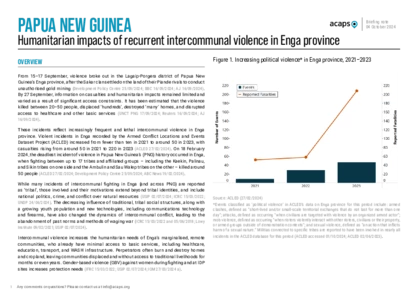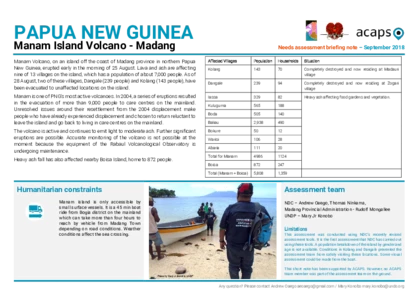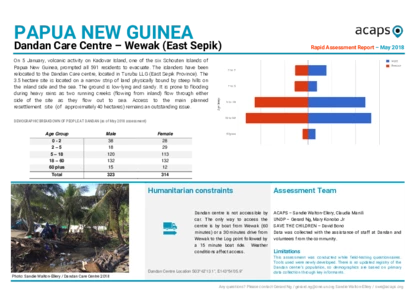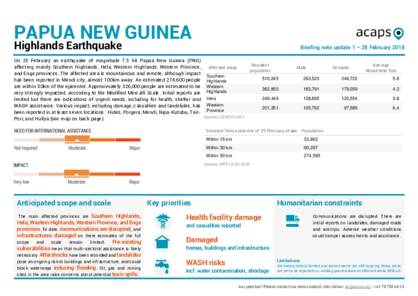Latest updates on country situation
08 October 2025
A magnitude 6.6 earthquake struck near Lae city in Morobe province, Papua New Guinea, on 7 October 2025. The quake occurred at a depth of approximately 99km, with its epicentre located about 26km from the city. The tremor shook buildings and caused widespread panic, but there have been no immediate reports of fatalities or major structural damage. Assessments are underway, and no tsunami warning has been issued. (Reuters 07/10/2025, AA 07/10/2025, RNZ 08/10/2025)
11 February 2025
On 26 January 2025, conflict broke out between two tribes in Karel village, Southern Highlands province, killing at least seven people and injuring several others. The hostilities damaged or destroyed homes, churches, schools, a health centre, and water infrastructure. The conflict has displaced around 1,700 people, who require emergency shelter, water, food, WASH, and protection assistance. (OCHA 05/02/2025)
12 November 2024
The Aiya local-level government in Papua New Guinea’s Southern Highlands province experienced heavy rains and strong winds from 11–12 October 2024, causing floods and landslides. By 1 November, the impact had affected around 14,000 people, around 1,800 of whom were displaced. The flooding and landslides significantly damaged homes, water sources, and WASH facilities, disrupting food production and livelihoods. The affected people continue to urgently need food, potable water, and shelter. Poor road infrastructure, inadequate communications systems, a lack of electricity supply, and security issues related to tribal violence in the flood-affected areas limit humanitarian access. (IOM 01/11/2024, UNCT PNG 08/11/2024)
24 September 2024
There has been a significant rise in tribal violence in Enga province since mid-September 2024, especially in Lagaip-Porgera district. The violence has caused a significant number of displacements and casualties, the widespread damage and destruction of property, and the disruption of essential services. The estimated number of fatalities ranges from 20–50. Increased security measures, including curfews, are in place in some of the affected areas. Initial assessments indicate that there are significant humanitarian needs, including food and access to medical care and other essential services.
Insecurity, violence, and logistical challenges are hindering aid delivery. (UNCT PNG 17/09/2024, Crisis24 23/09/2024, The Diplomat 17/09/2024)
28 May 2024
On 24 May 2024, heavy rains triggered a major landslide in Tulpar community in Yambali village, Enga province. Around 2,000 people could be buried under the debris. The landslide displaced 1,650 people and affected nearly 8,000. Immediate needs include shelter, WASH kits, healthcare services, and the facilitation of rescue efforts. (ECHO 28/05/2024 a, ECHO 28/05/2024 b, Govt. Australia 27/05/2024)
16 April 2024
As at 10 April 2024, floods and landslides resulting from heavy rains since March had affected around 90,000 people in Central, Eastern Highlands, Enga, Gulf, Jiwaka, Simbu, and Western Highlands provinces. Those affected urgently need food, potable water, blankets, tents, shelter tools, and WASH items. (Govt. Japan 12/04/2024)
02 April 2024
As at 8 March 2024, around 45% of the violent incidents and 75% of related fatalities in Highlands region had occurred in Enga province since the 2022 elections. Political and intercommunal violence has resulted in an estimated 25,500 IDPs in the province, with around 5,450 displaced since February 2024. Most of them rely on the host community for food, drinking water, shelter, and WASH infrastructure, putting pressure on the latter’s already limited resources. Recurrent tribal fighting has also destroyed many of the host community’s food gardens. The strain on WASH facilities has resulted in inadequate sanitation, long queues for basic hygiene needs, and open defecation practices, posing public health risks. IDPs face significant protection risks, especially gender-based violence, because of violence and insecurity in the area. The women and children who make up most of the IDP population need particular mental health and psychosocial support. (ACLED accessed 03/04/2024, IOM 26/03/2024, IOM 19/12/2022)
current crises
in
Papua New Guinea
These crises have been identified through the INFORM Severity Index, a tool for measuring and comparing the severity of humanitarian crises globally.
PNG003 - Conflict in Highlands
Last updated 28/11/2025
Drivers
Conflict/ Violence
Crisis level
Country
Severity level
1.7 Low
Access constraints
2.0
Analysis products
on
Papua New Guinea
31 May 2024
Papua New Guinea: humanitarian impact of landslide in Lagaip - Porgera district
DOCUMENT / PDF / 961 KB
On 24 May 2024, at 03:00 local time, heavy rains contributed to a landslide in Lagaip-Porgera district, Enga province, with the most severe effects in and around Yambali Ward. Up to 8m of soil and rubble buried people, homes, infrastructure, and farmland and damaged the sole road leading to Yambali.
07 September 2018
Papua New Guinea: Manam Island Volcano
DOCUMENT / PDF / 668 KB
Manam Volcano, on an island off the coast of Madang province in northern Papua New Guinea, erupted early in the morning of 25 August. Lava and ash are affecting nine of 13 villages on the island, which has a population of about 7,000 people. As of 28 August, two of these villages, Dangale (239 people) and Kolang (143 people), have been evacuated to unaffected locations on the island.
22 May 2018
Papua New Guinea: Dandan Centre Needs Assessment
DOCUMENT / PDF / 811 KB
On 5 January, volcanic activity on Kadovar Island, one of the six Schouten Islands of Papua New Guinea, prompted all 591 residents to evacuate. The islanders have been relocated to the Dandan Care centre, located in Turubu LLG (East Sepik Province).
01 March 2018
Papua New Guinea: Highlands Earthquake
DOCUMENT / PDF / 852 KB
On 25 February an earthquake of magnitude 7.5 hit Papua New Guinea affecting mainly Southern Highlands, Hela, Western Highlands, Western Province, and Enga provinces. The affected area is mountainous and remote, although impact has been reported in Mendi city, almost 100km away. An estimated 274,600 people are within 50km of the epicentre.






